
Matron is the job title of a very senior or the chief nurse in several countries, including the United Kingdom, and other Commonwealth countries and former colonies.

Matron is the job title of a very senior or the chief nurse in several countries, including the United Kingdom, and other Commonwealth countries and former colonies.

The chief nurse, in other words the person in charge of nursing in a hospital and the head of the nursing staff, is also known as the Chief Nursing officer or Chief Nursing Executive, senior nursing officer, [1] matron, [2] nursing officer, [3] or clinical nurse manager in UK English; the head nurse or director of nursing in US English, [4] [5] and the nursing superintendent or matron in Indian English, among other countries in the Commonwealth of Nations. [6] [7]
In England, matrons today "have powers over budgets, catering and cleaning as well as being in charge of nurses and doctors" and "have the powers to withhold payments from catering and cleaning services if they don't think they are giving the best service to the NHS." [2] Historically, matrons supervised the hospital as a whole but today, they are in charge of supervising two or three wards. [8]
The chief nurse is a registered nurse who supervises the care of all the patients at a health care facility. The chief nurse is the senior nursing management position in an organization and often holds executive titles like chief nursing officer (CNO), chief nurse executive, or vice-president of nursing. They typically report to the CEO or COO.
In the United States a matron is not a nurse, but a female assistant to males running a residential facility, like a camp, boarding school, or prison (see Other uses, below).
The word "matron" is derived from the Latin for "mother", via French.
The title of matron was first used in the 16th century in the United Kingdom (UK) for the housekeeper role in voluntary hospitals. [9] The radical reforms of nursing promoted by Florence Nightingale argued not just that nurses should be trained but that the hospital nursing staff and their training should come under the control of one senior nurse – the matron. [9] [10] Across the UK the pattern emerged in the late nineteenth and early 20th century in many hospitals, that the matron was the head of: the nursing service; the nurse training; and the hospital housekeeping and lived in the hospital. [9] [10] In some hospitals the matron was responsible directly to the institution's Board of Governors [10] but in others the matron might report to a senior physician or surgeon. [11] Matrons during this period were female. They were often seen as fearsome administrators, but were respected by nurses and doctors alike. [12] [10] [13] The Nightingale model of matron was taken to other countries in the British Empire. [14] Many matrons were active leaders in organizations advocating for the training and registration of nurses in Great Britain and Ireland :the British Nurses' Association(established 1887) ;The Hospitals Association registration committee (established 1887); The Matrons Council of Great Britain and Ireland (established 1894); and the College of Nurses Ltd (established 1916). [9]

With the advent of the National Health Service (NHS) in 1948, the new administrative arrangements resulted in every hospital having a matron, working in partnership with principal administrative officer and senior doctors in the day to day administration of the hospital, and responsible for the nursing service , the training of nurses and some domestic services (although increasingly in the larger hospitals domestic services were largely the responsibility of the principal administrative officer)l. [10] However, hospitals and the services they delivered were becoming more complex . The new NHS administratively grouped hospitals together (sometimes just two but many in to larger groups of up to 20 [15] ) resulting in the majority of matrons having less contact and influence with the governing body. [10] By the early sixties there were increasing disparities between hospitals in the types ,titles , job descriptions and work undertaken by senior nurses, particularly between those with the title' matron'. The Royal College of Nursing (RCN) published a review of the administrative arrangements for nursing in the NHS , arguing that the traditional role of matron was outdated, untenable in the range of duties, inadequately remunerated and increasingly difficult to recruit to. [15] The review also proposed new senior nursing administration structures for the NHS in which the title matron was changed to 'Hospital Nursing Officer' for an individual hospital and the title Chief Nursing Officer to the Board or Group Nursing Officer for the matron on the executive body of the group of hospitals [15]

Following extensive lobbying by the RCN and the Association of Hospital Matrons [16] Enoch Powell MP, the Minister of Health (England and Wales) and Michael Noble, Secretary of State for Scotland, appointed a Committee 'to advise on the senior nursing structure in the hospital (ward sister and above) "p1. [10] The Committee was chaired by Brian Salmon, member of the governing body of Westminster Hospital. [17] The appointed members included notable matrons and chief male nurses: Miss M B Powell CBE (matron St. George's Hospital , London); Miss J T Locke OBE (matron the Victoria Infirmary, Glasgow); Miss E. M. Rees,(matron Cardiff Royal Infirmary, Cardiff); Miss G. M. Westbrook,(matron Southmead Hospital, Bristol); J. Greene, Esq., (Chief Male Nurse, Moorhaven Hospital, Ivybridge, South Devon). [17]
The Report of the Committee on Senior Nursing Structure (known as the Salmon Report) was published in 1966 and proposed a new structure for NHS nurse managers which replaced the title matron and chief male nurse with 'chief nursing officer' and created a template job description and pay grade to be used by every NHS organization. [10]
The report's main recommendations on the structure of nursing administration, the change of name from matron to chief nursing officer, the simplified grading structure, and systematic preparation for management responsibility were accepted by the Minister of Health Kenneth Robinson and William Ross, Secretary of State for Scotland. [18] Pilots of the new structures commenced in 1968 and in the same year the Department of Health & Social Security decided to implement the new structure nationally, removing the title 'matron' from the NHS job title lexicon. [12]
Hospital matrons promoted nurses and nursing through the media of radio, newspapers and books e.g. Gwendoline Kirby, matron of Great Ormond Street Hospital, London was a guest on Desert island Discs, [19] Muriel Powell, matron of St George's Hospital London featured in the Star London newspaper in 1958 and spoke regularly on BBC radio and television programmes. [20]
The hospital matron was caricatured in the Ealing Comedy Carry on series in Carry On Nurse in 1959 and Carry On Doctor in 1963 (and gentler portrayals in Carry On Again Doctor and Carry On Matron ) and played by Hattie Jacques. The matron usually had a very distinctive uniform, with a dark blue dress (although often of a slightly different colour from those worn by her direct subordinates, the sisters) and an elaborate headdress.
Matrons also worked in boarding schools in the UK from the late-nineteenth century [21] until the 1990s. They acted to same way with the students as they did with nurses with one exception, they had to assign chores to students by the Headteacher when they misbehaved as a punishment such as doing the laundry, cleaning brass work or cleaning the floor. The matron also checked that all students were dressed in the way the uniform policy stated as well as having them make their beds in the same way as hospital beds.
In 2001 the UK Government announced the return of the matron to NHS hospitals in England, electing to call this new breed of nurses "modern matrons," in response to various press complaints of dirty, ineffective hospitals with poorly disciplined staff. [2]
They are not intended to have the same level of responsibility as the old matrons, as they often oversee just one department (therefore a hospital may have many matrons—one for surgery, one for medicine, one for geriatrics, one for the emergency department, etc.) but do have budgetary control regarding catering and cleaning contracts. In larger hospitals some will have a group of wards to manage.
Their managerial powers are more limited, and they spend most of their time on administrative work rather than having direct responsibility for patient care. [22]
Many areas of the UK now employ Community Matrons. The role of this staff group is predominantly clinical and these matrons have a caseload of patients for whom they are clinically responsible. Many of these patients have chronic health conditions such as COPD, Emphysema, and/or palliative conditions which result in multiple hospital admissions. It is the aim of this staff group to treat the patient within the community thereby limiting hospital admissions. This staff group are predominantly nurses, but there are other allied health professionals also in the role such as paramedics and occupational therapists.
The nursing branches of the British Armed Forces have never abandoned the term "Matron", and it is used for male as well as female officers, usually holding the rank of major (or equivalent) or above. It was formerly used as an actual rank in the nursing services.
In South Africa and its former mandated territory South-West Africa (today's Namibia), Matron is the rank of the most senior nurse of a hospital. [23]
Long before women were commonly employed as fully sworn police officers, many police forces employed uniformed women with limited powers to search and attend to female prisoners and deal with matters specifically affecting women and children. These female officers were often known as "police matrons". Officers in women's prisons sometimes also used the title of "matron"; sometimes the matron was a senior officer who supervised the other wardresses.
Institutions such as children's homes and workhouses were also run by matrons. The matron of a workhouse was very often the wife of the master and looked after the domestic affairs of the establishment. This was, in fact, the original meaning of the term. Its use in hospitals was borrowed from workhouses.
The term was also used in boarding schools (and is still used in some British independent schools) for the woman in charge of domestic affairs in a boarding house or the school nurse. In the past, the matron was sometimes the wife of the housemaster.
In the Church of Jesus Christ of Latter-day Saints, the female spouse of a temple president or his counselors is referred to as a temple matron.
In New York City, movie theater matrons were employed beginning in 1936 to ensure that children would behave in theaters. They were licensed by the Department of Health until 1943, and the ordinance that required their hiring and selection was formally repealed by the city in 1995. [24]
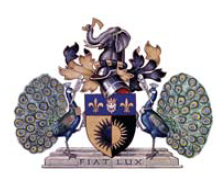
Moorfields Eye Hospital is a specialist National Health Service (NHS) eye hospital in Finsbury in the London Borough of Islington in London, England run by Moorfields Eye Hospital NHS Foundation Trust. Together with the UCL Institute of Ophthalmology, which is adjacent to the hospital, it is the oldest and largest centre for ophthalmic treatment, teaching and research in Europe.

The Royal London Hospital is a large teaching hospital in Whitechapel in the London Borough of Tower Hamlets. It is part of Barts Health NHS Trust. It provides district general hospital services for the City of London and Tower Hamlets and specialist tertiary care services for patients from across London and elsewhere. The current hospital building has 845 beds and 34 wards. It opened in February 2012.
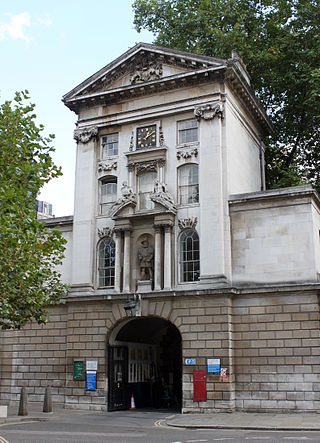
St Bartholomew's Hospital, commonly known as Barts, is a teaching hospital located in the City of London. It was founded in 1123 and is currently run by Barts Health NHS Trust.
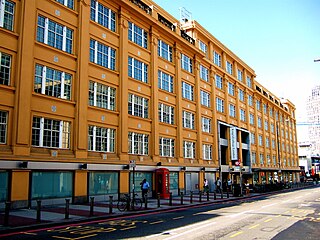
The Florence Nightingale Faculty of Nursing, Midwifery & Palliative Care is an academic faculty within King's College London. The faculty is the world's first nursing school to be continuously connected to a fully serving hospital and medical school. Established on 9 July 1860 by Florence Nightingale, the founder of modern nursing, it was a model for many similar training schools through the UK, Commonwealth and other countries for the latter half of the 19th century. It is primarily concerned with the education of people to become nurses and midwives. It also carries out nursing research, continuing professional development and postgraduate programmes. The Faculty forms part of the Waterloo campus on the South Bank of the River Thames and is now one of the largest faculties in the university.

Whipps Cross University Hospital is a large university hospital in the locality of Whipps Cross in Leytonstone and is within Epping Forest in the London Borough of Waltham Forest, London, England. It is managed by Barts Health NHS Trust.

The Royal National Orthopaedic Hospital (RNOH) is a specialist orthopaedic hospital located in the London Borough of Harrow, United Kingdom, and a part of Royal National Orthopaedic Hospital NHS Trust. It provides the most comprehensive range of neuro-musculoskeletal health care in the UK, including acute spinal injury, complex bone tumour treatment, orthopaedic medicine and specialist rehabilitation for chronic back pain. The RNOH is a major teaching centre and around 20% of orthopaedic surgeons in the UK receive training there.
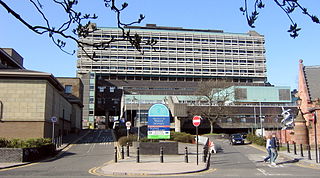
The Western Infirmary was a teaching hospital situated in Yorkhill in the West End of Glasgow, Scotland, that was managed by NHS Greater Glasgow and Clyde. It was opened in 1874 and closed in 2015.
Agenda for Change (AfC) is the current National Health Service (NHS) grading and pay system for NHS staff, with the exception of doctors, dentists, apprentices and some senior managers. It covers more than 1 million people and harmonises their pay scales and career progression arrangements across traditionally separate pay groups, in the most radical change since the NHS was founded.
Nursing in the United Kingdom has a long history. The current form of nursing is often considered as beginning with Florence Nightingale who pioneered modern nursing. Nightingale initiated formal schools of nursing in the United Kingdom in the late 19th and early 20th centuries. The role and perception of nursing has dramatically changed from that of a handmaiden to the doctor to professionals in their own right. There are over 700,000 nurses in the United Kingdom and they work in a variety of settings, such as hospitals, health centres, nursing homes, hospices, communities, military, prisons, and academia, with most working for the National Health Service (NHS). Nurses work across all demographics and requirements of the public: adults, children, mental health, and learning disability. Nurses work in a range of specialties from the broad areas of medicine, surgery, theatres, and investigative sciences such as imaging. Nurses also work in large areas of sub-specialities such as respiratory, diabetes, cancer, neurology, infectious diseases, liver, research, cardiac, women's health, sexual health, emergency and acute care, gastrointestinal, infection prevention and control, neuroscience, ophthalmic, pain and palliative, and rheumatology. Nurses often work in multi-disciplinary teams but increasingly are found working independently.
Nursing management consists of the performance of the leadership functions of governance and decision-making within organizations employing nurses. It includes processes common to all management like planning, organizing, staffing, directing and controlling. It is common for registered nurses to seek additional education to earn a Master of Science in Nursing or Doctor of Nursing Practice to prepare for leadership roles within nursing. Management positions increasingly require candidates to hold an advanced degree in nursing.
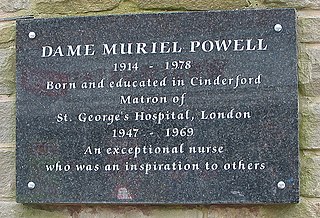
Dame Muriel Betty Powell, DBE, was a British nurse, hospital matron, nurse educator, public servant, and Chief Nursing Officer (CNO) for the Scottish Home and Health Department (SHHD) 1970-76.

Pilgrim Hospital is a hospital in the east of Lincolnshire on the A16, north of the town of Boston near the mini-roundabout with the A52. It is situated virtually on the Greenwich Meridian and adjacent to Boston High School. The fenland area of Lincolnshire is covered by this hospital, being the county's second largest hospital after Lincoln County Hospital. It is managed by United Lincolnshire Hospitals NHS Trust.

St Leonard's Hospital is a hospital in Hoxton, London.

The Metropolitan Free Hospital was a London hospital, founded in 1836 and based for most of its existence in Kingsland Road, Hackney. It became part of the NHS in 1948, and closed in 1977, with its residual functions transferring to Barts Hospital.
The history of nursing in the United Kingdom relates to the development of the profession since the 1850s. The history of nursing itself dates back to ancient history, when the sick were cared for in temples and places of worship. In the early Christian era, nursing in the United Kingdom was undertaken by certain women in the Christian Church, their services being extended to patients in their homes. These women had no real training by today's standards, but experience taught them valuable skills, especially in the use of herbs and folk drugs, and some gained fame as the physicians of their era. Remnants of the religious nature of nurses remains in Britain today, especially with the retention of the job title "Sister" for a senior female nurse.
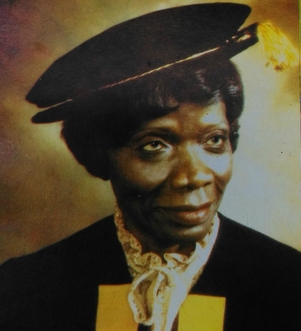
Chief Kofoworola Abeni Pratt Hon. FRCN was a Nigerian nurse who was one of the first notable black nurses to work in Britain's National Health Service. She subsequently became vice-president of the International Council of Nurses and the first black Chief Nursing Officer of Nigeria, working in the Federal Ministry of Health.

The Grove Hospital, originally the Grove Fever Hospital, was a hospital for infectious diseases opened in Tooting Grove, London.

Dulwich Community Hospital was a hospital located in Dulwich, in South London.
Bethnal Green Hospital was an acute care hospital, in Bethnal Green in the London Borough of Tower Hamlets, England. It opened in 1900, and it closed in 1990.
The Salmon Report (1966) or the Salmon Report on Senior Nursing Staff Structure was the report of a committee established to bring standardisation in structure and pay for senior hospital nurses in England and Scotland. The report recommended changes to how nurses jobs were categorised in hospitals and management training for nurses.
Mr Milburn said the modern-day matrons were an attempt to drive up standards in hospitals and prevent hospital infections, by ensuring hygiene standards are met on the ward. Matrons will earn up to £31,000 a year and will have powers over budgets, catering and cleaning as well as being in charge of nurses. They will also have the powers to withhold payments from catering and cleaning services if they don't think they are giving the best service to the NHS.
Nursing Superintendent/Matron. The Matron will be responsible to the MS for the administrative and technical aspects of nursing in the hospital. Her charter of duties will include the following: (1) Administration of nurses, their accommodations and messing, viz. equitable distribution and economic utilization of nursing staff, maintenance of duty roster, turnout and discipline; supervision ...
There is a Nurses Hostel having mess facility, where about 300 students and staff nurses are accommodated. Adjacent to this, there is a new hostel with single room accommodation, constructed in 1970, where 50 staff nurses are residing. There is also a double storied building where Assistant Matrons, Tutors and Sisters are accommodated. The Senior Matron is provided family accommodation.
But the modern matron does not have the seniority of her predecessor and instead of running the whole hospital might have three or four wards.